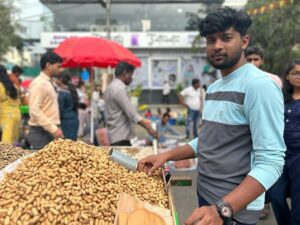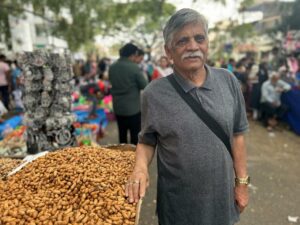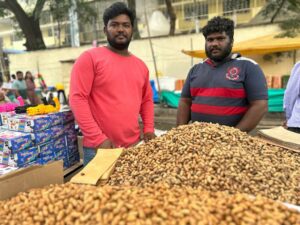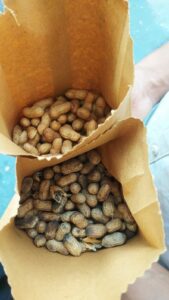For the city of Bengaluru, Kadlekai Parishe or groundnut fair, is a crucial annual event that is held at the end of the Karthika month.

On 8 December, the festival saw the unofficial commencement with crowds thronging the street to grab the first lot of the produce brought in by farmers from Tamil Nadu, Andhra Pradesh and parts of Karnataka. (South First/Rama Ramanan, Deeksha Devadiga)
It’s an emotion etched in 60-year-old Utkarsh Gowda’s memory — cool Karthika maasa mornings, the fragrance of roasted, boiled kadlekai, in the background of seekers ringing the bell at the bull temple, known as Basavanagudi.
For the city of Bengaluru, Kadlekai Parishe or groundnut fair, is a crucial annual event that is held at the end of the Karthika month. The groundnut festival first took place in 1537 AD, with a legendary tale involving Kempegowda himself.
This year, on 8 December, the festival saw the unofficial commencement with crowds thronging the street to grab the first lot of the produce brought in by farmers from Tamil Nadu, Andhra Pradesh and parts of Karnataka. The festival was officially inaugurated on 11 December 2023 and will conclude on 13 December.
For the past 486 years, except the pandemic years, Bengaluru’s Basavanagudi street has been thick with the aroma of kadlekai and chirpy, haggling crowds.
“Legend has it that Karnataka used to have groundnut farms, but the crop used to be ruined at night by a bull. The bull, my grandfather used to tell me, is the guardian of Lord Shiva. So, the locals had to appease Lord Shiva to stop the bull from killing their crops and thereby their livelihood. They pledged to offer the first harvest of groundnuts to Shiva,” shares Anantha Kumar, a vendor from Tumkur, who has been participating in the event for the last 8-10 years.
For Kalasipalaya resident Nagesh and his family, too, the Kadlekai Parishe is a long-standing tradition that was started by his grandfather. For the last 40 years, his family has been selling groundnuts at the fair. Seated at the entrance of the street, with a mountain of groundnuts laid out on a sack, Nagesh thrives in the vibrancy that fills the air at Basavanagudi at this time of the year. “I remember coming with my grandfather and then, my father. This is not my main profession. I sell scrap for a living, but during the Parishe, I come with my children to sell groundnuts,” he tells South First.
At first glimpse, the street seems like an all-inclusive fair. We find the entire stretch lined with vendors selling clothes, toys, pots and pans, and jewellery. We wonder if we are in the wrong location. A passerby notices our confused appearance and points towards the far end of the lane indicating the location of the groundnut vendors.

Karthik from Salem is debuting at the festival with his homegrown groundnuts. (South First/Rama Ramanan)
Elbowing our way through some enthusiastic college-going girls booing each other, we finally locate a cart loaded with two varieties of kadlekai. “This is naatu kadlekai and this is hybrid,” shares Karthik from Salem who is debuting at the festival with his homegrown groundnuts.
“This is not our main profession. Back home, we have different kinds of crops that we grow. I came here this year to witness the festival and crowd since I have heard so much about it,” he shares.
Vouching for the flavour and taste of the naatu variety, Karthik hands over a handful for us to try. The crunch, the crispness and the flavour seem quite refreshing from the ones that are found round the year in supermarkets. There’s a reason, we surmise, why local, seasonal produce is always a winner.
Like Gowda, 76-year-old Bengaluru resident Keshava Murthy too has been a regular at the festival since he was 10 years old. “I come here for the crowds. I feel the crowd is cheerful, and everyone is happy here. That makes me happy. I used to come alone when I was younger. Then, after marriage, my wife joined me on this annual pilgrimage to the Kadlekai Parishe,” narrates Murthy.

76-year-old Bengaluru resident Keshava Murthy has been a regular at the festival since he was 10 years old. (South First/Rama Ramanan)
He prefers the naatu variety.
“It’s tastier than the hybrid one. Every year, I buy at least 3-4 kilos from different vendors. I give some to my daughter who also lives in Bengaluru. As a family, we enjoy this yearly ritual. And this groundnut is very healthy. These days, youngsters don’t understand the importance of these things in their diet. They want to eat all kinds of food but not focus on health. Why do you think I am still fit? It’s these groundnuts,” he shares emphatically.
Brothers Kavi Arasu and Prashanth from Dharmapuri, however, seem worried. Of the 300 kg groundnuts that they brought from their hometown, only 100 kg has been sold so far. “Slight aa tension irrukku. Indha varsham sales kami thaan. (We are slightly tense. This year, the sale has been lesser than the previous years.), says Prashanth.

This is the fifth year at the festival for Dharmapuri brothers Kavi Arasu and Prashanth. (South First/Rama Ramanan)
Pointing towards the crowds around us, Prashanth says, “This is our fifth year. I love coming here for the crowd. Unfortunately, no one realises the importance of groundnuts anymore. It has immense nutritional value.”
Usually, the crowd mills around all the groundnut vendors, vigorously haggling, but this year, the brothers noticed a dip in numbers. “We are calling out to people, asking them to try and then purchase. This has never happened before. Usually, the demand is high,” informs Kavi Arasu.
This is Andhra-born, Bengaluru-resident Reshma’s first time at the fair as well. “I was hoping to sell a good volume but couldn’t do much on the first day,” she says. However, after a few words of wisdom from her friends, who have also put up stalls at the fair, Reshma was hopeful. Just as we move on from her stall, we hear two customers buying groundnuts from her, and watch the smile return on her face.
As we buy a few packets of the naatu variety from the Dharmapuri brothers, they inform us in unison, “No plastic bag, only paper cover.”

Following the plastic ban, vendors at the festival are using only brown paper bags. (South First/Deeksha Devadiga)
Owing to the temple management’s decision to prevent the use of plastic bags in the locality, vendors seem to strictly follow the ban. We are, of course, watching and applauding customers following this environment-friendly practice.
Clutching his brown paper bag of peanuts, Gowda is a happy man. “I brought my grandchildren here for the first time so that they can witness a local fair like this. Otherwise, kids are only interested in malls and movies. This is a novel experience for them to know the history and heritage of our land,” he notes.
In an era where experiences are limited to digital media, local fairs and festivals like Kadlakei Parishe are a reminder of community living in a real world that celebrates history and heritage.
(With added inputs from Deeksha Devadiga))

May 15, 2024

May 14, 2024

May 14, 2024

May 14, 2024

May 13, 2024

May 13, 2024